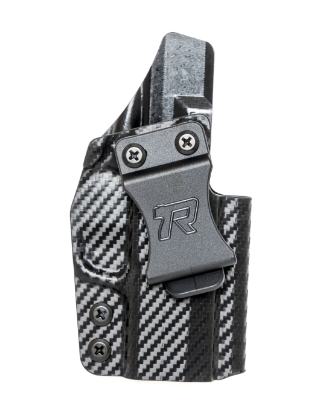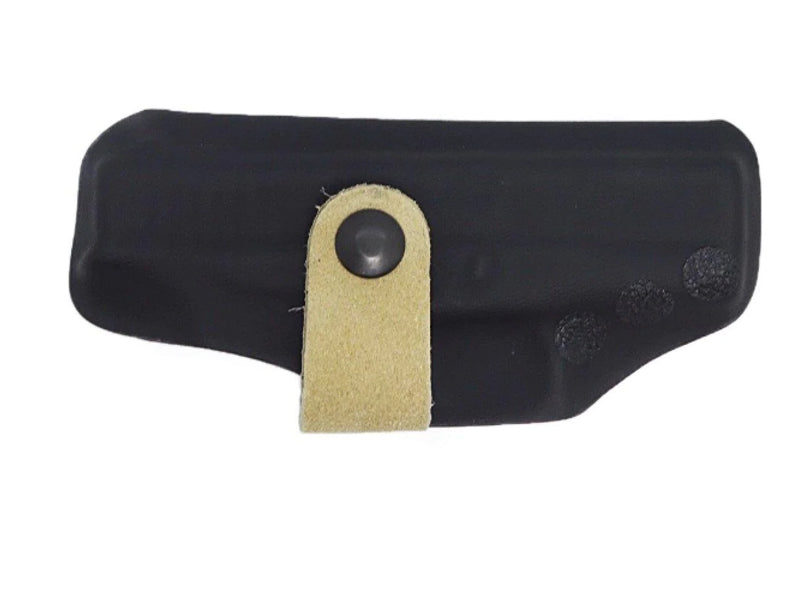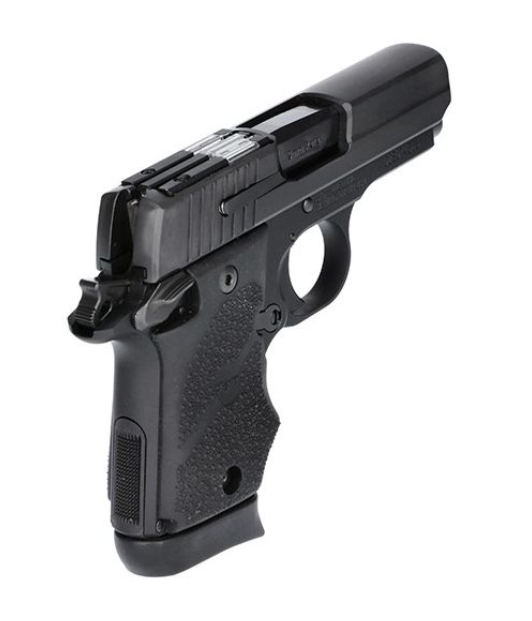Written by Mark Buff, GunZee founder and CEO.
Big fellows have some unique concerns with concealed carry. A good CCW holster designed for fat guys will do wonders. So will the right inside the waistband (IWB) position.
Read on to find out what is the best IWB position that will make concealed carry the easiest and most comfortable.
Quick links:
How to choose the right IWB holster?
No matter your size, you deserve comfort. With GunZee holster pad you’ll experience the pure comfort of IWB carry.
CCW for large dudes is a different game
Concealment Express IWB Holster.
Image source: https://shop.roundedgear.com/collections/classic-iwb-kydex-holsters
You’re trying to strike a balance between security, comfort, and accessibility, all of which can be harder to achieve if you’re really big. Different folks have the fat distributed to different bodily locations, so your unique makeup can complicate matters.
Before you choose any holster or position, let’s look at friction points that plump individuals face:
- Skin irritation. Extra weight around the midsection can lead to sweat buildup, chafing issues, and general skin irritation from the holster and gun rubbing against fold or rolls.
- Spare tire. A protruding stomach or "spare tire" can make appendix carry positions difficult or impractical.
- Love handles. Excess fat deposits around the hips and sides can squish against the grip of the gun causing discomfort in strongside positions.
- Back fat. Excess mass across the lower back impacts comfort and accessibility for rear-positioned holsters and guns, especially while sitting.
- Body shape. Larger waist and chest circumferences along with thicker torso profiles impact overall comfort, flexibility, and access when drawing and holstering.
- Range of motion. Thick layers of body fat surrounding joints can hinder obtaining a solid two-handed grip or fully extending arms when drawing from a holster. The excess padding limits wrist rotation and elbow extension needed to properly control and aim firearms.
Which IWB position should you choose as a fat guy?
Although it can be tricky, it is possible to reclaim effective carry, even if you’re a plus-sized CCW enthusiast. With practical adjustments that account for a larger frame, you can find the right IWB position.
Here are our top IWB position options to consider:
- Appendix carry
- 4-5 o’clock carry
- Strongside hip
- Small of back
- Crossdraw
Appendix carry
Appendix carry, where the firearm is positioned in the front of the body between the 1 o'clock and 2 o'clock positions, allows for quick draw access along with effective concealment. The natural curves along the front of the body can obscure the outline of the firearm.
Benefits of appendix carry:
- Allows for a very quick draw stroke due to the forward position of the body and easy accessibility for either hand.
- The centered position enables fluid access without overextending.
Considerations with appendix carry:
- Finding an optimal ride height may require testing different AIWB holsters and adjustments. KYDEX holsters let you bump your weapon and minimize the risk of accidental discharge.
- Seated comfort can be impacted depending on body shape and holster choice. Try different backing lengths and materials to ease pressure points.
- Pay attention to muzzle direction during drawing.
- As body shape changes over time, holsters and wardrobes may need to be reevaluated to match comfort and accessibility needs.
4-5 o'clock carry
4-5 o'clock carry refers to a rearward waistline carry position, generally centered behind the hip from 4 o'clock to 5 o'clock for right-handed shooters or 7-8 o’clock for left-handed shooters. This rearward position around the waistline area enables the firearm and grip to remain obscured while seated.
Benefits of 4-5 o'clock carry:
- Comfortable for many body sizes and shapes thanks to its location toward the rear of the waistline.
- Provides excellent concealment while in a seated position. The firearm and grip remain hidden while sitting.
- Allows clothing, such as untucked shirts, to conceal the firearm while standing.
Considerations for 4-5 o'clock carry:
- The draw stroke may be slower compared to other positions due to the rear location.
- While more comfortable than the appendix for seated carry, some users may still experience discomfort from grip pressure when sitting for longer periods of time.
- Accessibility for support side draws may be impeded by body positioning. Difficult to pivot the firearm effectively from that direction.
Strongside hip
Strongside hip carry refers to positioning the firearm on the dominant side of the body, generally centered forward of the rear pant pocket. This enables good accessibility and comfort for most body types.
This position provides comfort while standing, as the grip clears the typical waistline. It also conceals reasonably well when standing or walking.
Strongside hip carry works well for larger waistlines compared to other spots. It avoids most sweat buildup issues that can occur with other carry locations.
Potential drawbacks include:
- Sitting can push the grip outward
- Grips can poke into the hip bone causing discomfort when seated
- It can be difficult to draw while seated
- Shirts may ride up and reveal the firearm when bending over
Small of back
Small of back (SOB) carry is a position where the firearm is centered on the lower back around the 5:30-6 o’clock area. This can enable good concealment by using the natural curve of the spine to obscure the outline.
SOB carry gives comfort while standing and walking, as the grip clears the typical waist indent. It conceals pretty well when upright or moving.
Benefits of strongside hip carry:
- Comfortable for extended wear while remaining mobile thanks to ample clearance from the hipbone and stability on the waistline.
- Full-range arm movement enables a smooth draw stroke from the instinctive position.
- Avoids sweat buildup issues that can occur closer to the body front.
Considerations for strongside hip carry:
- While seated, the grip may point outward depending on holster depth and body shape. Strategic garment lengths help.
- Fixed vehicle seats can push the muzzle rearward. Be mindful of direction control when exiting.
- Shirts may rise when bending, revealing the firearm. Retention properties are important to prevent overexposure when moving.
Crossdraw
Crossdraw carry positions the firearm horizontally across the body's midline. Typically the firearm is located at the 1-2 o'clock area for right-handed shooters or 10-11 o'clock for left-handed or ambidextrous shooters.
Benefits of crossdraw carry:
- Conceals well while facing forward. Torso hides the grip from a frontal view.
- Works well for larger waist sizes that may be impeded by other carry spots.
- Aids reholstering by aligning the body with the holster location.
Considerations for crossdraw carry:
- The draw stroke requires reaching across the body, which may be slower and less efficient than other positions.
- Muzzling one's outer arm is a risk if rotation is misdirected on the draw.
- Accessibility is extremely limited for the support-side hand.
- While concealed well from forward view, a side profile with the arm extended or bending can reveal the grip.
Choosing the right IWB holster
The right IWB holster is important for comfortable and concealable CCW carry. Here are some tips for choosing the concealed carry holster for larger body types:
- Select an adjustable cant holster. The angle of the holster against your body (the cant) needs to be optimized based on body shape to maximize comfort and concealment.
- Prioritize a molded back for daily carry. A rigid, molded back will keep the gun securely pressed to your body without flexing or collapsing as a soft back would with excess mass.
- Choose a model with adjustable retention and ride height. Being able to customize the vertical position and tension for your specific frame reduces pressure points.
- Consider a tuckable design. If you tuck in dress shirts, look for tabs that easily conceal when shirts are tucked in for versatile carry.
- Get an overhook model if carrying appendix position. This wrap-around belt clip shifts the grip of the gun inwards for better concealment on the stomach.
- Select moisture-wicking fabrics. Sweat-resistant materials like hybrid KYDEX and neoprene backing reduce excessive sweating.
- Size up. Don’t assume you wear the same pant-size holster. Measure where the holster sits and size accordingly to distribute weight.
- Try different backing shapes. The holster body shape impacts comfort dramatically—try oval, wing, or contour shapes.
- Try different holster types. The market is flooded with quality holsters you can choose from. Read, inform yourself, and try different types until you find the perfect one for you.
- Add a cushion pad. The GunZee memory foam pad makes a world of difference for comfort. It creates a smooth buffer to distribute pressure evenly across the torso while wicking moisture. The extra cushioning opens up more carry position options without irritation or poking.
Clothing consideration for CCW carry
Experiment with clothing choices to find comfortable, accessible everyday carry. Focus on breathable materials with dynamic fits. Do your best to strike the right balance of comfort, accessibility, and concealment. Here are some tips to follow:
- Seek out loose, flowy shirts and tops that don't cling tightly to the body. Avoid thin, form-fitting materials that could reveal the outline of a firearm. Breathable cotton and performance fabrics are ideal.
- Look for button-up shirts, polos, and tunics that extend past the waistline. Longer tail ends help keep the gun concealed when bending or reaching.
- For tucked shirts, use a quality undershirt to create a smooth base layer, reducing skin irritation and friction. Breathable performance fabrics that wick moisture are preferable.
- Opt for pants with a gusseted crotch and articulated knees to allow greater mobility. Consider pants featuring stretch panels or fabrics with some give to them.
- Try pants with a higher waist to allow mounting holsters at different ride heights. A waistband at or slightly above belly level helps stabilize a holster.
- Suspenders and supportive belts are useful to transfer the weight of a loaded gun effectively without sagging. Wide, rigid gun belts excel at burden-bearing.
- Where legal, a jacket, sports coat, or vest worn as an outer layer builds additional concealment through busy patterns and more coverage.
Hide your gun under the right clothing and then apply our holster pad to enjoy the pure comfort of CCW carry!
IWB positions for fat guys FAQ
What is the best holster position for fat guys?
The best holster position for fat guys is usually appendix carry or 4-5 o'clock carry. It utilizes the front waist curve to obscure the firearm's shape while the 4-5 o'clock position tucks it behind the hip without uncomfortable abdomen contact when seated.
What is the most comfortable IWB carry position?
The most comfortable IWB carry position balances stability, accessibility, and minimal pressure points which for many is the strong-side hip at about 4 o'clock. This keeps the grip clear of fat folds while enabling a smooth, instinctive draw stroke unimpeded by excess mass on the torso.
What is the best concealed carry method for skinny people?
Inside the waistband carry at the appendix position is often the most effective method for skinny people. The close-fitting gun essentially vanishes along the vertical front, obscured by the slim profile when viewed face-on thanks to limited protrusions.
Learn more about the best CCW holsters for skinny guys.
What is the best concealed handgun for big hands?
The best concealed handgun for big hands is likely a double stack model like the Glock 45, SIG P320, or Smith & Wesson M&P. These offer increased grip circumference and extended controls to leverage thicker fingers and wider palms effectively with a solid hold.
Which is better, a vertical or horizontal shoulder holster?
Vertical shoulder holsters allow easier access to draw the firearm while keeping it streamlined next to the ribcage concealed under an outer garment. The muzzle end angles downward in a vertical config, preventing unintended flagging.
Is a belly band holster good for fat guys?
A belly band holster can be a good option for larger gentlemen if it is sized appropriately. Look for bands made of elastic material that will stretch to fit larger waists comfortably while still securing a firearm close to the body for concealment. Bands with velcro adjustments allow customization of fit.
Is shoulder carry better than IWB?
Shoulder carry isn't better or worse than IWB, both have tradeoffs. IWB wedges grips close into the body for security but can poke over time. Shoulder carry leaves IWB comfort issues behind but requires consistent garment coverage to stay hidden.
What is the purpose of the wing on the IWB holster?
The wing on an IWB holster helps press the grip tighter to the body through leverage for stabilization. This prevents the bottom of the grip from flaring outward while filling the space between the grip and body with the wing shape.
What is the difference between IWB and tuckable IWB?
A tuckable IWB holster features small plastic clips to enable tucking a dress shirt in over the body, while the clips secure the belt above. This provides concealment under professional attire that normally resists covering firearms.
What is the best cant angle for appendix carry?
An optimal cant angle for appendix carry holsters tends to be around 15 degrees allowing a natural draw angle in-line with the torso while keeping the barrel end tipped inwards along the centerline of the body.
About the Author
Mark Buff is the founder and CEO of GunZee. He is an ardent firearms enthusiast and has been carrying concealed for more than 15 years. He created GunZee to solve his own problem: that of uncomfortable KYDEX holsters. His patented GunZee memory foam holster pad makes inside-the-waistband carry super comfortable.
Further reading
What is the easiest pistol to conceal?
What is the best semi-auto for women?
What are the best EDC holsters to get?
What is the best Beretta for concealed carry?
What are the best subcompact handguns?
What are the best 9mm single-stack pistols?




